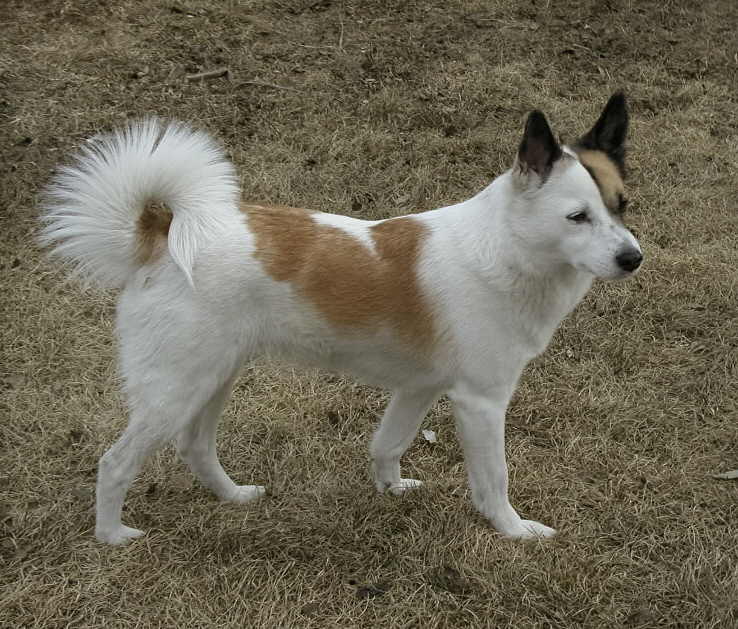Type the name of the breed you're looking for below
[wpdreams_ajaxsearchlite] Don't see the breed your're looking for? Click here and let us know!
Breed Characteristics
1 paw - breed exhibits the least amount of this characteristic
5 paws - breed exhibits most amount of this characteristic
Norrbottenspets
| Other Names | Nordic Spitz, Pohjanpystykorva, Norrbottenspitz |
| Country of Origin | Sweden |
| Weight | 26 - 33 lbs. (12 - 15 kg) |
| Height (at withers) | Males: 17.5 - 18 in. (44.5 - 45.5 cm) Females: 16.5 - 17 in. (42 - 43 cm) |
| Coat | The coat is hard, straight, dense, and lies close to the body. It must always have a double coat (although after a coat loss, the undercoat can be rather sparse), and the under-coat is softer than the outer-coat. |
| Colour | The ground colour is white, with yellowish red or reddish brown markings. Also, markings of other colours are permitted. The ideal amount of white varies from 30% to nearly 100%, but in extreme cases it should have colour at least on the ears and a small spot near the base of the tail. The more coloured dogs must have a broken saddle(white crossing completely over the shoulders) with the white clearly dominant. Symmetry is not essential in facial colouring, nor is any pattern more correct than another. White on both ears, however, is highly correlated with deafness and is not desirable. Ticking(small spots of 0.25-1.0 cm) is allowed, as is a dark face. There is a gene that is dominant that leads to the dark coloured mask on the face. Often, the mask is accompanied by dark tipping of the guard hairs. For a show dog, symmetrical colour can be preferred, but structure and the original purpose are always the most important |
| Litter Size | 4 - 6 puppies |
| Life Span | 12 - 14 years |
| Origin & History | The breed originated in Norrbotten, Sweden and Lappland/Kainuuland, Finland, and have been documented as early as the 17th century. Sweden and Finland argue about the true home of the Norrbottenspets, but clearly the dog has spent much time in both countries. The dogs were mainly used as hunting companions. By the end of World War I, the Norbottenspets came close to extinction. Due to the very small number of norrbottens, Sweden closed its studbook in 1948. Although some dogs were preserved, they were in a non-Swedish speaking area and in the far north as a farm dog and companion. Enthusiasts sought out the few remaining dogs and started a successful breeding program between the 1950s and early 1960s. FCI confirmed a new breed standard in 1966 and the official name was confirmed as Norrbottenspets. In 1967 the Swedish Kennel Club accepted the breed for registration and a new standard was written. Finland accepted the standard and began registering dogs in 1973. In Finland these dogs are called Pohjanpystykorva. Immigrant farmers have given the dog an even longer name, Norbottens-skollandehund. There is a great effort in Finland to ensure the health of these fox-like hunting dogs and breeding is highly controlled. Healthy animals, that are only distantly related, are being bred with careful consideration of breeding consultants to create a strong background. Sweden has also had a dramatic impact on the preservation of this breed through strict breeding practices. |
| Personality | The Norrbottenspets is an alert, lively, and intelligent breed, they're never shy, nervous or aggressive. Friendly and fun loving, they especially love children. The Norrbottenspets is a plus as a house pet in that they are not the great barker that most of the other Nordic hunters are. |
Care Requirements
| Health | There are no known breed-specific health concerns. |
| Grooming | This is a naturally neat and clean breed. The coat requires only brushing and combing to keep them looking great. They are naturally lustrous and shake clean. |
| Exercise | This is a hunting dog that needs extensive amounts of exercise. Without it, the dog could become problematic for its owners. It should be taken on walks daily, and this dog is great for healthy people who love to jog and hike. |
| Other Considerations | While it can live in an apartment, it may perform better in a small yard. It is important for owners to make sure this dog is never unleashed in an unsecured area, as it may run off in the direction of the first interesting scent it picks up. It is important for owners to make sure these dogs are given lots of space to move around in. |



